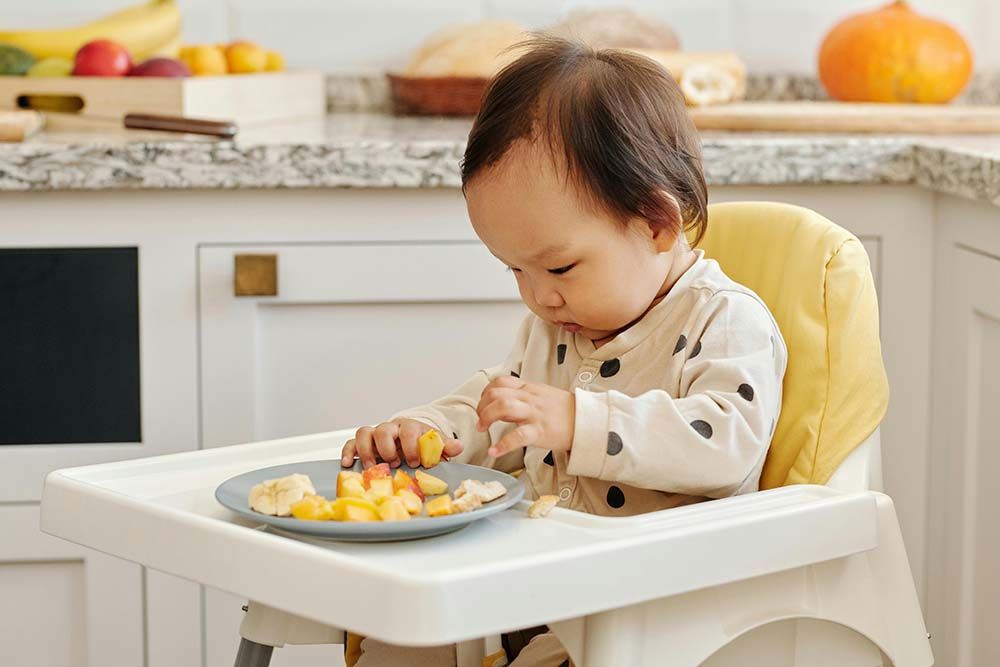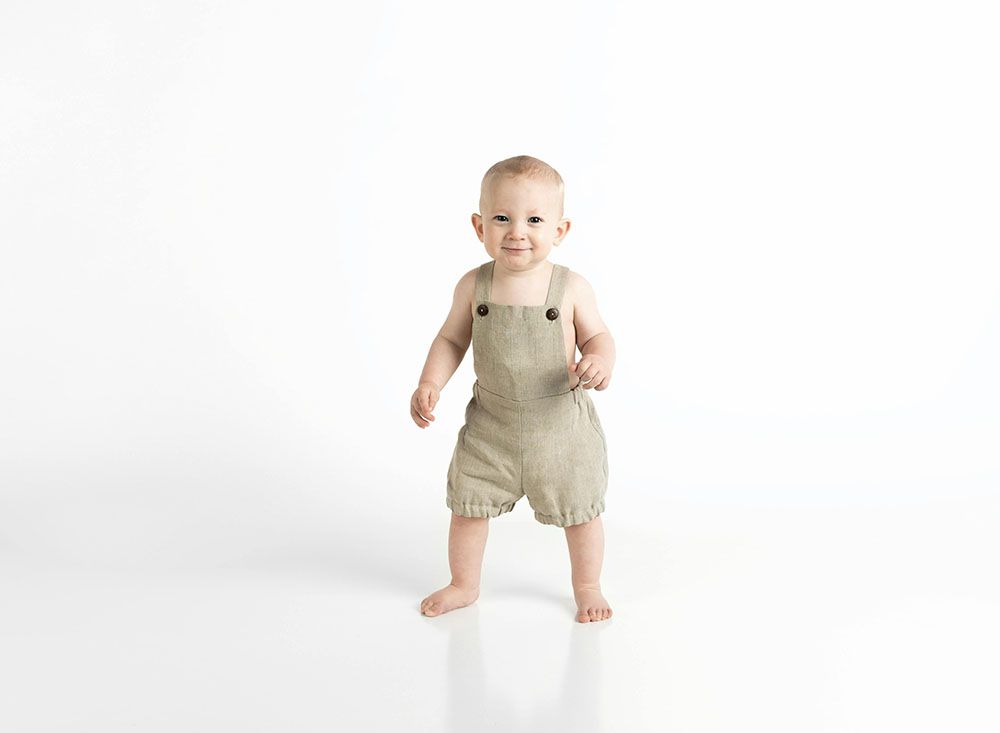

According to the newest research, Baby-led weaning is beneficial in preventing obesity and promoting healthy development for babies. Actually, except for developing healthy eating habits, it also improves the hand-eye coordination and independence. However, without correct guidance, it will cause more dangerous issues. Thus, this article will guide you how to start baby led weaning at home easily, enabling your baby to enjoy self-feeding.
Moonycare App is really helpful!
During the BLW process, parents need to record their baby's daily eating habits, especially whether the baby has food allergies, interest in accepting new foods, and the amount of food they eat. And Moonycare is such a useful baby track designed for new parents, which can help you easily record your baby's eating habits, types of complementary foods, allergic reactions, etc. These records help parents understand the baby's dietary preferences and growth needs, and allows parents to adjust the types of complementary foods and feeding methods. In addition, Moonycare can not only help parents record their baby's complementary food progress, but also track their baby's sleep, defecation and other important activities at the same time, permitting parents to fully understand their baby's health status.
IN THIS ARTICLE
What are the benefits of baby led weaning?
When to start baby led weaning?
Useful tips for baby led weaning
How to start baby led weaning?
Recommended food for baby led weaning
Foods to avoid with baby led weaning
What is Baby-led Weaning?
Baby-led weaning is an approach to encourage babies to feed themselves on their own by introducing solid foods, bypassing liquidized or smashed food given with a spoon. On the contrast, they can use their fingers to choose what they want to eat and decide how much they need. And parents or other caregivers don't need to purchase extra food specifically, instead, you can serve the same meals as the rest of the family. But remember to adjust portion sizes, making the food manageable for your little one to hold.
This concept was jointly proposed by Gill Rapley and Tracey Murkett, which has gained great popularity among modern families, particularly in UK and US. They advocate having babies sit at the table to learn how to eat at mealtime, and practise self-feeding a lot when they grow a bit older, which is largely favored by those parents who want to prevent selective eating and foster independence in their children.
What are the Benefits of Baby-led Weaning?
Be more independence: Baby-led weaning allows babies to take meals independently, permitting them to determine the variety and amount of food they consume.
Increase social interactions: When your baby sits at the table, your family can't wait to tease your baby, resulting in more interactions. What's more, baby will imitate others' eating behavior, such as chew or swallow.
Taste new foods: This allows babies to eat various foods with different favors, helping babies develop a variable and healthy diet habits. Besides, early exposure to diverse foods may reduce the likelihood of causing food allergens when they grow up.
Cut down the risk of being obesity: When baby starts to eat on their own, they can eat on personal pace and stop when they are full, which reduce the risk of overeating compared to being spoon-fed by others.
Development more skills: During this process, it exercises manual ability, the corporation skill with eye and hand, as well as fine motor skills required for eating, like tongue movements, chewing, and swallowing.
Convenient for eating out: Since babies eat the same food as adults, it is convenient to take them to out for meals, such as going to a friend's house or a restaurant.
Save unnecessary expenditure in time and money: It takes time when you need to prepare meals for your baby and family separately. And money can also be saved because your baby will eat the same food as your family and will reduce milk-feeding accordingly.
However, each coin has two sides. A large number of parents worry that solid foods might cause choke because babies are too small. But, with your careful precaution and full-time supervision, it will be fine. Another trouble of independent eating is the awful mess it creates. Babies have not yet mastered the skills of eating with their hands and may play with food sometimes, leading to a messy table after meals for you to clean.
When to Start Baby-led Weaning?
When you notice the following signs on your baby, you can consider starting baby-led weaning:
-
Sit up by themselves without others'support
-
The tongue thrust reflex has disappeared
-
Can reach and hold objects tightly with hands
-
Can bring food into mouth smoothly and swallow them
-
Begin to show interest in solid foods
Actually, many experts suggest that 6 months is an ideal age to start baby-led weaning, because babies at this age can basically meet the above standards and are developmentally capable of self-feeding. Thus, supplementing breast milk feeding with solid foods at 6 months is appropriate.
However, if you are worried about whether your baby at 6 months is ready to eat solid foods, in case of safety, you can consult with your pediatrician or nursing expert for professional guidance.
Useful Tips for Baby-led Weaning
-
During the initial process, cook the solid food s that are soft enough for little babies to chew, and cut all foods into pieces that are suitable for babies to hold, chew and swallow. But don't give too small and hard things, which may easily cause choke.
-
When babies eat different foods initially, they may spit them out because of unfamiliarity. You should wait and allow baby to handle gagging independently. Gagging is a normal part of learning to eat, but choke is a serious emergency. You should learn the difference between them.
-
Full-time supervision is necessary. Don't leave your baby alone when eating. Keep at least one person around your baby's side in case of choke and other safety issues.
-
Provide positive reinforcement when your baby starts to try different foods. By doing so, the encouragement can motivate them to explore new tastes and textures.
-
Watch for your baby's reaction to new foods to avoid allergic reactions. If there are any discomfort, go to medical help instantly.
How to Start Baby-led Weaning?
At first, make sure your baby can sit upright and face to the table.
You can give them soft sticks or strips of food, allowing your baby to practise how to grasp them with their hands. Remember to avoid the dangerous foods.
At this time, baby still receives most nutrients from breastfeeding or bottle feeding, so don't worry about the amount of sold food that they consume. The key is to make your baby get accustomed to the new way of eating, and learn how to move the foods in mouth and swallow them. So, it's beneficial to let your baby eat with your family, which is convenient for them to imitate how to chew and swallow from your family members.
Provide one simple food at a time initially. Be patient because your baby needs time to learn to eat. It is normal if your baby rejects to the food at first. You can continue to provide the same food for more times, allowing your baby to familiar with the favor and texture. Or if your baby accepts the food immediately, you can also wait a few days before trying a new food to observe whether there is allergic reaction to your baby.
With time flies, you can gradually introduce various types of foods, making your baby not selective in food later in life. But it is also necessary to watch your baby's reaction closely when trying new foods, rush for medical attention if your baby has allergic reaction or any discomfort feelings.
Baby-led Weaning Foods
When you select the first baby-led weaning food, each food should be selected based on its ease of handling, nutritional value and safety. If you are hesitant to choose which one, some of the best baby-led weaning foods are listed below for you to check.
Fruits:
-
Bananas: Ripe bananas are easy to crush with gums, making them perfect for babies.
-
Avocados: Soft and creamy, rich in healthy fats.
-
Peaches or plums: Cut into wedges, peeled to prevent choking.
-
Apples: Cook or peel and slice thinly.
-
Blueberries: Small and soft, help practice finger grip.
-
Watermelon: Seedless, cut into small cubes or strips.
Reasons:
-
Fruits are naturally sweet and very attractive to babies.
-
They are soft and easy to mash, reducing the risk of choking.
-
They provide vitamins and minerals that are essential for growth and development.
Vegetables:
-
Carrots: Steam until soft and cut into strips.
-
Sweet potatoes: Roast or steam and cut into wedges.
-
Courgettes: Steam until tender and cut into strips.
-
Green beans: Cook until soft, can be mashed or pureed.
-
French beans: Cook slightly to soften, keep whole.
-
Pumpkin: Roast and cut into small pieces.
Reasons:
-
Vegetables are nutritious and provide essential vitamins and fiber.
-
They are easy to prepare and can be made soft enough for babies to handle.
-
Different colors and textures can stimulate baby's interest and desire to explore.
Proteins:
-
Chicken: Cook until very tender and tear into small pieces or cut into small pieces.
-
Fish: Boneless and cook until soft, such as salmon or tilapia.
-
Eggs: Boil or scramble and cut into small pieces.
-
Tofu: Soft tofu and cut into small pieces.
-
Lentils or beans: Cook until soft and mash or puree.
Reasons:
-
Protein is vitalfor muscle development and overall growth.
-
They provide essential amino acids and iron.
-
Soft proteins are easier for babies to chew and digest.
Grains:
-
Rice cakes: Soft and easy to break apart.
-
Whole-wheat bread: Toast and slightly moisten to soften.
-
Pasta: Cook until slightly firm and cut into small pieces.
-
Oatmeal: Cook until soft and serve as finger food.
-
Quinoa: Cook until soft and mix with pureed fruit or vegetables.
Reasons:
-
Grains provide energy and are a good source of carbohydrates.
-
They are easy to prepare and can be mixed with other foods.
-
Whole grains provide more fiber and nutrients.
Dairy:
-
Cheese: Soft cheese like mozzarella, cut into small pieces.
-
Yogurt: Plain yogurt, thick and creamy, with no added sugar.
Reasons:
-
Dairy products provide calcium and protein.
-
Soft cheeses are easier for babies to chew and swallow.
Foods to Avoid with Baby-led Weaning
In addition, some foods may contain potential risks. Here is also a list of foods to avoid.
Nuts and seeds:
-
Whole nuts: Such as peanuts, almonds, walnuts, etc.
-
Whole seeds: Such as melon seeds, sunflower seeds, etc.
Reason:
-
Nuts and seeds are hard and can easily cause choking.
-
Unprocessed nuts and seeds may also cause allergic reactions.
Round and smooth foods:
-
Whole grapes
-
Whole cherry tomatoes
-
Hard candies: Such as lollipops or other hard candies.
-
Soft candies: Such as jello candies or other soft candies.
Reason:
-
These foods are round and smooth and can easily slide down the throat, causing choking.
-
Round foods are not easy for babies to chew.
Hard or hard to chew foods:
-
Raw carrots
-
Celery
-
Apple slices (uncooked)
-
Hard bread
Reason:
-
These foods are hard and difficult for babies to chew and swallow.
-
Uncooked foods may cause choking.
Foods with bones:
-
Fish with bones
-
Meat with bones
Reason:
-
Bones can easily cause choking or hurt the mouth.
-
Foods with bones need to be handled with special care to prevent babies from swallowing bones.
Crumbly or sticky foods:
-
Popcorn
-
Marshmallows
-
Soft and sticky rice
Reason:
-
Popcorn and marshmallows can be easily inhaled into the respiratory tract.
-
Soft and sticky foods can easily stick in the mouth and cause choking.
Processed foods and high-salt/high-sugar foods:
-
Hot dogs
-
Sausages
-
Pickled foods
-
Sugar-sweetened beverages
Reason:
-
Processed foods are usually high in sodium and sugar, which is not good for the health of babies.
-
These foods may contain additives and are not suitable for infants.
Foods that are prone to allergies:
-
Honey (under 1 year old)
-
Seafood: Such as shrimp, crab, etc.
-
Certain fruits: Such as citrus fruits, may cause allergic reactions.
Reason:
-
Honey may contain botulism spores, which are potentially dangerous to babies under 1 year old.
How to Distinguish Between Gagging and Choking?
Since babies are too small to speak, it is urgent to figure out the detailed differences between gagging and choking.
1. Definition
Gagging:
Gagging is the phenomenon that the baby's throat reflexively expel food because the food is too large or difficult to swallow.
This is a normal physiological reaction that helps prevent food from entering the windpipe.
Choking:
Choking is when a foreign object gets stuck in the airway, blocking airflow.
This is an emergency and requires immediate action.
2. Causes
Gagging:
Large food: Food pieces are too large to chew and swallow.
Hard food: Food texture is too hard to handle.
Choking:
Food stuck: Whole nuts, grapes, cherry tomatoes, etc.
Toy parts: Small parts, beads, etc.
Other small objects: Coins, pen caps, etc.
3. Symptoms
Gagging:
Retching: The baby may make a "uh huh" sound and try to spit the food out of his mouth.
Facial expression: The baby may show an uncomfortable or confused expression.
Coughing or spitting out food: The baby may solve it by coughing or spitting out food.
Choking:
Inability to speak or make sounds: Your baby may try to make sounds but be unsuccessful.
Face change: Your baby may turn blue or red.
Grabbing the throat: Your baby may grab his throat to show discomfort.
Coughing: If your baby is able to cough, he may be trying to clear the obstruction; but if coughing doesn't work, immediate action is needed.
Difficulty breathing: Your baby may show rapid breathing or be unable to breathe at all.
4. Solutions
Gagging:
Stay calm: The baby may panic, so stay calm and comfort the baby.
Let the baby handle it by themselves: Give the baby time to handle the food, usually they will cough or retch to expel the food.
Encourage to keep trying: The baby may be afraid of eating because of gagging, so encourage them to keep trying.
Choking:
Immediate first aid measures: Such as the Heimlich Maneuver.
Back slaps: For smaller babies, back slaps and chest thrusts can be used.
Cardiopulmonary resuscitation (CPR): If the baby loses consciousness, CPR should be performed immediately.
Emergency medical treatment: Call the emergency number immediately and request professional medical assistance.
Last Words
This article has showed you when and how to start baby-led weaning, along with the recommended and avoided foods, helping your baby transition to self-feeding successfully and establish healthy eating habits. However, some researches have pointed that babies who perform the baby-led weaning are easily to be underweight and vulnerable to nutrient deficiencies, such as lacking of icon. Thus, pay close attention to your baby's condition, keeping them away from this possible potential risks.























